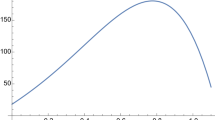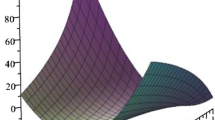Abstract
It is shown that a nonstationary evolution equation solution admits two universal representations. The first is a canonical factorization into an infinite product of exponentials. This representation involves a nonstandard “integral type” Lie algebra from which an extended Hall set can be extracted. This result can be thought of as the formal continuous analogue of a Lazard factorization of the free monoid.
It is also shown that a second canonical representation into a single exponential is possible, thus making an earlier work of Magnus [6], continued by Michel [14], more precise. In the sequel, reverse time together with duality problems are discussed. Finally, the evolution operator for a general Lie derivative is shown to lead to tractable combinatorial problems.
Similar content being viewed by others
References
M. Lothaire, Combinatorics on words, inEncyclopedia of Mathematics and Its Applications, Addison-Wesley, New York, 1983.
M. Fliess, Fonctionnelles causales non linéaires et indéterminées non commutatives,Bull. Soc. Math. France,109 (1981), 3–40.
T. Huillet, A. Monin, and G. Salut, Exponentiation d'algèbres de Lie dans la représentation des systèmes non linéaires, Rapport LAAS No. 85253, 1985.
N. Bourbaki,Groupes et Algèbres de Lie, Hermann, 1972, Chaps. 2 and 3.
G. Viennot,Algèbres de Lie Libres et Monoïdes Libres, Lecture Notes in Mathematics, vol. 691, Springer-Verlag, Berlin.
W. Magnus, On the exponential solution of differential equations for a linear operator,Comm. Pure Appl. Math.,7 (1955), 649–673.
T. Huillet, A. Monin, and G. Salut, Lie algebraic representations in non-linear control. Rapport Interne LAAS No. 86042 (submitted).
A. Kirillov,Elements de la théorie des representations, Editions Mir, Moscow, 1974.
K. T. Chen, Integration of paths, geometric invariants and a generalized Baker-Hausdorff formula,Ann. of Math.,65 (1957), 163–178.
R. Ree, Lie elements and an algebra associated with shuffles,Ann. of Math.,68 (1958), 210–220.
C. Lobry, Controlabilité des systèmes non linéaires,SIAM Journal Control Optim.,8 (1970), 573–605.
C. Lobry, Controlabilité des systèmes non linéaires, inOutils et Modèles Mathématiques pour l'Automatique, l'Analyse des Systèmes et le Traitement du Signal, vol. 1, Editions du CNRS, Paris, 1980, pp. 187–214.
R. Hermann and A. J. Krener, Nonlinear controllability and observability,IEEE Trans. Autom. Control,22 (1977), 728–740.
J. Michel, Bases des algèbres de Lie. Etude des coefficients de la formule de Campbell-Hausdorff, Thèse 3rd cycle, Orsay No. 55, 1974.
C. Reuteunauer, Sur la réalisation locale des séries génératrices de rang de Lie fini,Comptesrendus des Conférence sur les méthodes algébriques et géométriques en automatique non linéaire, Paris, June 3–7, 1985.
R. P. Feynman, An operator calculus having applications in quantum electrodynamics,Phys. Rev.,84 (1951), 108–128.
Author information
Authors and Affiliations
Rights and permissions
About this article
Cite this article
Huillet, T., Monin, A. & Salut, G. Lie algebraic representation results for nonstationary evolution operators. Math. Systems Theory 19, 205–226 (1986). https://doi.org/10.1007/BF01704914
Received:
Revised:
Issue Date:
DOI: https://doi.org/10.1007/BF01704914




